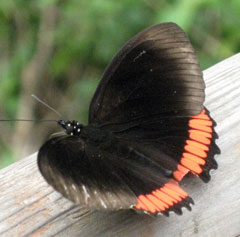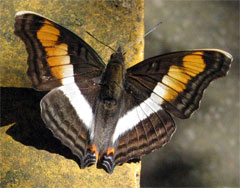
Throughout Costa Rica’s plentiful rainforests, beaches and mountains, visitors are enchanted by the number and variety of butterflies. Costa Rica boasts over 1000 butterfly species, more than the entire continent of Africa.
Flitting from flower to flower the butterflies are enchanting to watch, the brilliant colors of their wings lending joy to the day. These delicate wings are covered with tiny scales which reflect light passing through them to form bright colors and patterns. They serve to identify the butterfly to members of its own species as it seeks to carry out its sole mission in life, mating. The colors of some species, such as the Monarch, which are toxic when eaten, warn predators that these butterflies are not dinner.

The male butterfly spends his short time on earth cruising around looking for a female. With his antennae he can smell her perfume (pheromones) from over a mile away. At the back of his abdomen—remember, butterflies are insects so their bodies have three sections, a head, a thorax, and an abdomen—is a set of “claspers” to grab on to his lady love. When couples mate they face in opposite directions with their abdomens locked together. The female, if startled during the conjugal act, will fly up into the air carrying aloft her attached Don Juan. During her short lifetime she will lay about 100 eggs. Some species lay their eggs in clusters while others lay each egg on a different plant.

Upon hatching, the tiny caterpillars go into the world to eat. As adult butterflies are primarily sex machines, caterpillars are primarily eating machines, munching the night away, and remaining motionless during daylight hours to camouflage themselves from predators. The growing caterpillar sheds its skin four times, then searches for the perfect spot on the underside of a leaf to attach itself and prepare for the miraculous change from a crawling eating machine to a glorious flying butterfly.
The butterfly’s life is short, varying from species to species, but averaging about three months—two weeks as an adult butterfly.
Join us on a California Native tour to beautiful Costa Rica and witness this bounty of butterflies for yourself.
